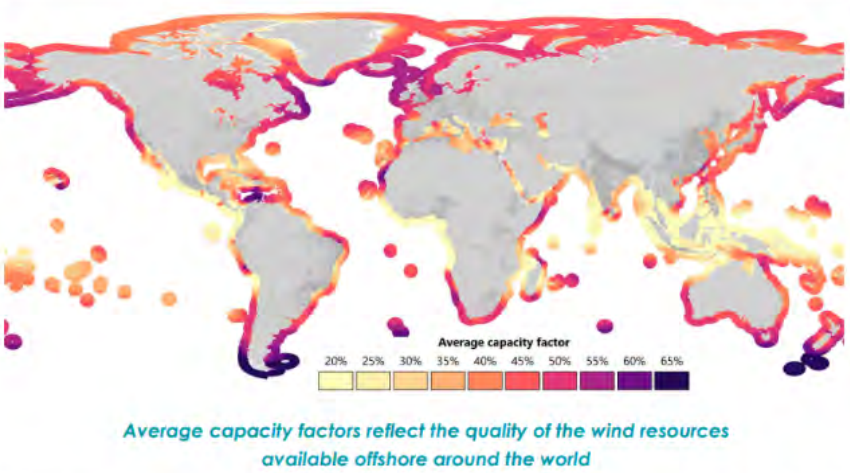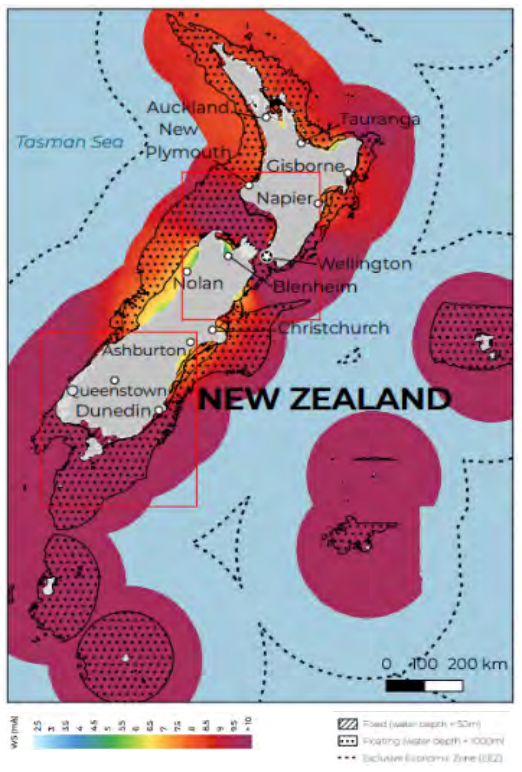Chapter 2: Context
On this page
Offshore renewables could contribute to our climate change goals
Aotearoa New Zealand needs a highly renewable, sustainable, and efficient energy system that is accessible and affordable, secure and reliable, and supports New Zealanders’ wellbeing. The
Government has committed to reaching net zero emissions for long-lived gases (carbon dioxide, nitrous oxide, F-gases and non-biogenic methane. Subsequently referred to as ‘carbon’ for
simplicity) by 2050, set a target that 50% of total energy consumption will come from renewable sources by 2035, and has an aspirational target of 100% renewable electricity by 2030.
The New Zealand Energy Strategy, currently in development and due to be completed by the end of 2024, will help set pathways to achieve our objectives and provide certainty for the sector, consumers, and industry. It will set the direction for New Zealand’s pathway away from fossil fuels and towards greater levels of renewable electricity and other low emissions alternatives.
Reducing our reliance on fossil fuels and moving towards greater levels of renewable energy and other low-emissions alternatives will increase demand for electricity over the coming decades. The
magnitude and timing of the increase is uncertain, but analysis by MBIE projects that electricity demand could grow between 18 and 78% between 2018 and 2050 across 5 different scenarios assuming different levels of economic growth, technological progress and policy changes.
Electricity demand and generation scenarios: Scenario and results summary, July 2019(external link)
Analysis by Transpower, the electricity grid operator, shows that demand could grow from ~43 TWh (terawatt hours) today to 70 TWh by 2050 primarily from electrifying transport and process heat.
Whakamana i Te Mauri Hiko - Empowering our Energy Future(external link) — Transpower
Recent Climate Change Commission (CCC) modelling to support its emissions budget advice also shows the potential for significant increases in demand for electricity out to 2050 as the number of electric vehicles (EVs) on the country’s roads grows, and industrial demand electrifies.
Ināia tonu nei: a low emissions future for Aotearoa(external link) — He Pou a Rangi Climate Change Commission
Offshore renewables can contribute to this increased demand for electricity, providing a more stable source of renewable energy, for more constant and predictable generation.
There are other potential benefits from developing offshore renewable energy
Offshore renewable energy can provide for increased economic development
Developments can generate economic benefits by creating jobs to support the manufacture, construction, and operation of infrastructure. A localised supply chain can add value to an economy by providing a range of components and services that are required. For example, the development of a typical 500 MW offshore wind farm requires around 2.1 million person-days of work and there are synergies with offshore oil and gas, specifically in terms of skills and occupational groups.
Offshore innovation widens renewable energy options: Opportunities, challenges and the vital role of international co-operation to spur the global energy transformation, 2018(external link) — International Renewable Energy Agency Offshore
Surplus renewable energy, such as that provided from offshore sources could be used to grow energyintensive activities. These potentially include the construction of data centres and the production of hydrogen or ammonia. Green hydrogen has potential as an alternative fuel source to decarbonise
many hard-to-abate industries and applications. Green ammonia can be used to create urea, which is widely used in the agricultural sector both as a fertilizer and animal feed additive. Both the green hydrogen itself, and its applications, such as green ammonia and urea could provide export opportunities for Aotearoa New Zealand.
Attracting these activities to Aotearoa New Zealand would reduce global greenhouse gas emissions and create sustainable high-wage jobs for New Zealanders. Suppliers with access to low-cost
renewables will tip the scales when it comes to green hydrogen production.
Major energy exporters race to lead in global hydrogen trade(external link) — Wood Mackenzie
There is an opportunity to enable technology innovation
The technologies to exploit offshore renewable energy sources are at different stages of development. There is an opportunity to enable technology developments and innovation, as well as investment in renewable offshore energy beyond wind. There is interest from innovative energy organisations in testing, trialling, and developing other renewable marine technology, including current, wave and tidal renewable electricity generation. It will be important to de-risk investment in both innovation and testing technologies.
Offshore wind is the most mature technology
Offshore wind technology is the most mature of the offshore renewable energy technologies today, and it continues to develop at pace. Offshore wind installations have the potential to provide
significant new renewable electricity generation capacity in the future. Offshore wind technology allows the exploitation of the generally higher and more consistent wind resources offshore, while achieving gigawatt-scale projects close to large load centres (eg the densely populated coastal areas prevalent in many parts of the world).*
Also, being at sea, offshore wind is less visible and less audible – key objections raised with regards to onshore wind developments in some communities.
* IRENA (2019), Future of wind: Deployment, investment, technology, grid integration and socio-economic aspects (A
Global Energy Transformation paper), International Renewable Energy Agency, Abu Dhabi.
Aotearoa New Zealand has world-class offshore wind resources
According to the International Energy Agency, Aotearoa New Zealand is optimally located in an area of the world with quality wind resources. The average capacity factor (average performance over the course of a year) for wind projects in Aotearoa New Zealand is estimated between 50 to 65%.
Offshore Wind Outlook 2019 [PDF 10.1MB](external link)
The least-windy sites in New Zealand have better wind energy potential than the windiest sites in Australia.

Source: International Energy Agency analysis developed in collaboration with Imperial College London based on Renewables.ninja
Image transcript
Water depth is another important technical consideration. Turbines are now routinely being installed in water depths of up to 40 metres and as far as 80 kilometres from shore. These turbines, rooted in the seabed by monopile or jacket fixed-bottom foundations, are easier to access and currently restricted to waters less than 60 metres deep. (IRENA (2019), Future of wind: Deployment, investment, technology, grid integration and socio-economic aspects (A Global Energy Transformation paper), International Renewable Energy Agency, Abu Dhabi)
Scaling up offshore wind markets requires offshore wind turbines to move into deeper waters with higher wind resources. Floating foundations offer this potential, as they allow access to sites with
deeper water and further from shore. Significant and encouraging developments in floating foundations have been seen in recent years. For example, the Norwegian energy company Equinor
will complete the world’s largest floating wind installation by 2023. Located 140 kilometres offshore with water depths ranging between 260 metres and 300 metres, it will have a system capacity of 88 MW. (IRENA (2020), Fostering a blue economy: Offshore renewable energy, International Renewable Energy Agency, Abu Dhabi.)
Floating offshore wind in deeper water is likely to become cost competitive with offshore wind on fixed foundations in shallower water by the early to mid-2030s, which will open up new markets with good wind resources close to population centres, but with deeper water. (Key Factors for Successful Development of Offshore Wind in Emerging Markets, pg.8.)
Offshore wind could be feasible in a number of locations in Aotearoa New Zealand
Based on wind quality and water depth alone, the technical potential for offshore wind in Aotearoa New Zealand is concentrated in a few different locations according to analysis by the Global Wind Energy Council in 2021.
Other technical factors will also influence the economic viability of an offshore wind project. These include distance from shore (near shore <60km or far from shore 60 – 300km), availability of grid connection, grid capacity, distance to port (for construction and
maintenance), and proximity to consumers. These are generally the first order considerations that offshore wind developers will take into account when identifying potential locations for projects.
A 2019 study of Aotearoa New Zealand’s offshore wind resource identified at least 7 GW of potential capacity from fixed foundation wind turbines in South Taranaki alone, with the potential for additional capacity from floating turbines, and in other locations. (C.A. Ishwar; I.G. Mason (2019), Offshore Wind for New Zealand, Proceedings of the EEA Conference and Exhibition, 25-27 June 2019, Auckland, NZ.)
In Aotearoa New Zealand, developers currently interested in offshore wind energy, both fixed and floating foundations, have identified the following potentially technically viable locations: Waikato, South Taranaki Bight, North Taranaki Bight, and Southland.
Annex 1 provides further information on the locations of developer interest:

Source: Global Wind Energy Council
Image transcript
The lifecycle of an offshore wind project
Offshore wind projects are long-term propositions. They can take a decade to establish and remain in operation for thirty years or longer. The 4 major stages in the lifecycle of an offshore wind project are feasibility, construction, operation and maintenance, and decommissioning.
Feasibility
The feasibility stage is an opportunity to determine the appropriate scale and location of offshore wind infrastructure. Determining this involves gathering all the information necessary to assess whether a project is technically, commercially, environmentally, culturally, and socially appropriate.
Feasibility activities can include geotechnical, geophysical, wind speed, and environmental and ecological impact surveys. They also include engineering and design studies, economic analysis,
onshore and human impact studies (such as visual impact), as well as assessing options for connecting offshore energy infrastructure to an electrical grid or directly to users. Depending on their nature, some feasibility activities may need consenting.
The data gathered during the feasibility stage would be used to inform the preparation of necessary consents and other permissions to construct and operate.
Construction
Constructing offshore wind energy infrastructure can cost hundreds of millions of dollars and take several years. There are a series of activities that take place to prepare the site and manufacture the components needed.
Operation and maintenance
Offshore wind infrastructure can be in operation for decades. It needs frequent maintenance and inspections to check that components are working efficiently. Ongoing compliance with health, safety and environmental regulation will also be a large part of the activities in this stage.
Decommissioning
Components, such as the turbines, will come to the end of their design life and will need to be decommissioned. As the majority of offshore wind energy infrastructure has been constructed in the
twenty-first century, there is little global experience in this area, but there are many similarities with offshore oil and gas, and lessons learned
< Chapter 1: Purpose of this consultation |Chapter 3: Why does the government need to enable feasibility activity now? >

